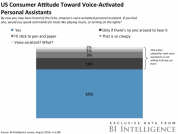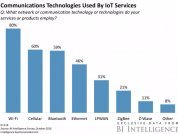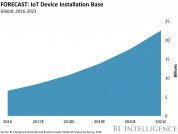This story was delivered to BI Intelligence IoT Briefing subscribers. To learn more and subscribe, please click here.
In a bid to expand the reach and use of voice control in the smart home, Google has updated the smartphone version of its Google Assistant to allow it to directly control smart home devices, reports The Verge.
This move, which brings features previously reserved for the company’s Google Home speaker hub to the Pixel line of phones, sheds light on Google’s larger home and voice strategies.
Companies fostering smart home ecosystems have followed one of two models so far:
- Hub-based ecosystems: Exemplified by Amazon, the ecosystem revolves around a connected hub like the Echo, which consumers use for convenience functions like basic search or music, as well as to control smart home devices. Amazon also uses the Echo to drive customers to its core e-commerce business.
- Device-based ecosystems: A notable example of this kind of ecosystem is Apple’s home offerings. This type of ecosystem may use a hub — Apple requires an Apple TV or iPad to handle that role — but a smartphone or tablet for interactions with smart home devices. This interaction can use voice or touch-based commands.
Google’s initial moves placed it in the hub-based category, but by migrating its features to mobile, the company’s smart home ecosystem will straddle the line between the two models. Allowing Pixel phones, and eventually other devices with Google Assistant, to control smart home devices, will enable wider availability and lower entry costs, boosting the number of consumers who are able to dive into Google’s smart home ecosystem.
This move may cut into potential sales of the Google Home speaker hub, but the company’s willingness to take that risk points to its overall smart home strategy. Google’s goal is not like Apple’s, which is to drive hardware sales, or Amazon’s, which is to facilitate e-commerce. Rather, Google’s interest is in driving the use of search, gathering data, and serving ads. Hardware sales can facilitate that, as can software updates to existing devices. Google will potentially be able to leverage the tens of millions of devices running Android software to control the smart home, driving growth in the segment while also pushing the company’s primary business.
The U.S. smart home market has yet to truly take off. At its current state, we believe the smart home market is stuck in the ‘chasm’ of the technology adoption curve, in which it is struggling to surpass the early-adopter phase and move to the mass-market phase of adoption.
There are many barriers preventing mass-market smart home adoption: high device prices, limited consumer demand and long device replacement cycles. However, the largest barrier is the technological fragmentation of the smart home ecosystem, in which consumers need multiple networking devices, apps and more to build and run their smart home.
BI Intelligence, Business Insider’s premium research service, has compiled a detailed report on the U.S. smart home market that analyzes current consumer demand for the smart home and barriers to widespread adoption. It also analyzes and determines areas of growth and ways to overcome barriers.
Here are some key takeaways from the report:
- Smart home devices are becoming more prevalent throughout the US. We define a smart home device as any stand-alone object found in the home that is connected to the internet, can be either monitored or controlled from a remote location, and has a noncomputing primary function. Multiple smart home devices within a single home form the basis of a smart home ecosystem.
- Currently, the US smart home market as a whole is in the “chasm” of the tech adoption curve. The chasm is the crucial stage between the early-adopter phase and the mass-market phase, in which manufacturers need to prove a need for their devices.
- High prices, coupled with limited consumer demand and long device replacement cycles, are three of the four top barriers preventing the smart home market from moving from the early-adopter stage to the mass-market stage. For example, mass-market consumers will likely wait until their device is broken to replace it. Then they will compare a nonconnected and connected product to see if the benefits make up for the price differential.
- The largest barrier is technological fragmentation within the connected home ecosystem. Currently, there are many networks, standards, and devices being used to connect the smart home, creating interoperability problems and making it confusing for the consumer to set up and control multiple devices. Until interoperability is solved, consumers will have difficulty choosing smart home devices and systems.
- “Closed ecosystems” are the short-term solution to technological fragmentation. Closed ecosystems are composed of devices that are compatible with each other and which can be controlled through a single point.
In full, the report:
- Analyzes the demand of US consumers, based off of survey results
- Forecasts out smart home device growth until 2020
- Determines the current leaders in the market
- Explains how the connected home ecosystem works
- Examines how Apple and Google will play a major role in the development of the smart home
- Some of the companies mentioned in this report include Apple, Google, Nest, August, ADT, Comcast, AT&T, Time Warner Cable, Lowe’s, and Honeywell.
To get your copy of this invaluable guide, choose one of these options:
- Subscribe to an ALL-ACCESS Membership with BI Intelligence and gain immediate access to this report AND over 100 other expertly researched deep-dive reports, subscriptions to all of our daily newsletters, and much more. >> START A MEMBERSHIP
- Purchase the report and download it immediately from our research store. >> BUY THE REPORT
The choice is yours. But however you decide to acquire this report, you’ve given yourself a powerful advantage in your understanding of the smart home market.
Learn more:
- What is the Internet of Things? Definition, Industries and Companies
- IoT Ecosystem – Forecasts and Business Opportunities
- IoT Market Size, Share & Growth Forecasts
- IoT Trends, Growth & Predictions
- IoT Devices, Applications & Examples
- Top IoT Companies to Watch & Invest In
- IoT Wearable Devices & Technology
- How IoT Will Affect Security
- IoT Reports










